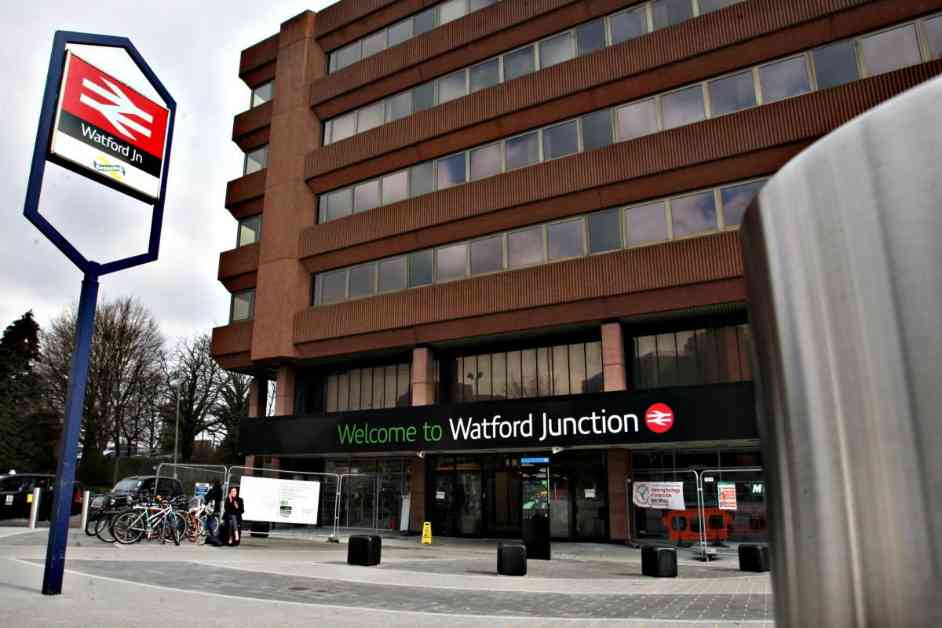**Navigating Rush Hour Chaos: Delays and Cancellations Impact Commuters**
Commuters using the Watford Junction station faced a morning of rail disruption due to a signalling fault near the station. National Rail issued warnings that some lines between Watford Junction and London Euston were closed as a result of the fault near Wembley Central. This led to changes in services, delays of up to 15 minutes, or cancellations of trains. The disruption was initially reported at 6:46 am and was expected to continue until at least 8:30 am. However, an update later revealed that the lines had reopened, but disruption was still anticipated until 8:30 am.
In another railway-related news, a ‘very sophisticated’ cyber attack has caused delays in the rollout of contactless train station technology. This incident highlights the vulnerabilities in modern transportation systems that can be exploited by cyber threats. In addition, residents have been warned about a scam involving parking charge texts, emphasizing the importance of vigilance against fraudulent activities targeting individuals.
The National Rail journey planner did not show any specific disruptions to trains at the moment, but this situation could change rapidly. Commuters affected by delays or cancellations may be eligible for compensation, and they are advised to check the train operators’ websites for more information on how to claim compensation for disrupted services.
Moving on to a remarkable incident captured on camera, an officer’s quick thinking and bravery were showcased when she climbed into a moving vehicle to assist a driver experiencing a medical episode in Mount Clemens, Michigan. The heart-stopping moment was recorded by traffic cameras and police bodycams, showing the deputy’s heroic actions to prevent a potentially tragic situation on the road. The driver was provided with medical assistance at the scene and later transported to the hospital for further treatment, highlighting the importance of swift and decisive responses in emergency situations.
In aviation news, European regulators have identified a potentially flawed cleaning process during maintenance as a possible cause of an engine fire on a Cathay Pacific Airbus jet. This incident prompted investigators to delve into the maintenance procedures of the aircraft and led to precautions being taken to ensure the safety of similar Airbus A350 jets. Despite the harrowing experience of the crew and passengers on the Zurich-bound flight, the situation was ultimately contained, thanks to the quick actions taken by the flight crew and emergency responders.
**Subheading: Impact of Rail Disruption on Commuters**
The disruption caused by the signalling fault near Watford Junction had a significant impact on commuters traveling between the town and London Euston. The closure of some rail lines and the resulting changes in services, delays, and cancellations created chaos during rush hour, affecting the daily routines of many passengers. Commuters were left scrambling to find alternative transportation or waiting anxiously for updates on the situation, highlighting the vulnerability of transportation systems to unexpected incidents.
For many commuters, delays and cancellations not only disrupt their schedules but also have broader implications on their work or personal commitments. The uncertainty caused by such disruptions can lead to frustration and stress among passengers who rely on a reliable and timely transportation system to navigate their daily lives. The need for clear communication and efficient resolution of railway issues becomes paramount in ensuring the smooth operation of commuter services and minimizing the impact on passengers.
**Subheading: Cyber Threats in Transportation Systems**
The ‘very sophisticated’ cyber attack that delayed the rollout of contactless train station technology serves as a stark reminder of the vulnerabilities present in modern transportation systems. As advancements in technology continue to shape the way we travel, the risks associated with cyber threats loom large, posing challenges to the safety and security of passengers and infrastructure. The incident underscores the importance of robust cybersecurity measures and proactive strategies to safeguard critical transportation networks from malicious actors seeking to disrupt operations.
In an era where digital connectivity is integral to the functioning of transportation services, the potential impact of cyber attacks on railway systems, airports, and other transit facilities cannot be underestimated. The need for constant vigilance, threat monitoring, and rapid response mechanisms to mitigate cyber risks is crucial in safeguarding the integrity and reliability of transportation infrastructure. As transportation authorities grapple with the evolving landscape of cyber threats, collaboration with cybersecurity experts and investment in secure technologies are essential to fortifying the resilience of transportation systems against potential attacks.
**Subheading: Ensuring Safety and Security in Aviation**
The engine fire incident on the Cathay Pacific Airbus jet highlights the complex maintenance procedures and potential risks associated with aircraft operations. As investigators probe the root cause of the incident, attention is drawn to the meticulous maintenance protocols and safety checks required to ensure the airworthiness of commercial aircraft. The European regulators’ response to the incident underscores the importance of thorough inspections and adherence to maintenance standards in preventing aviation incidents that jeopardize passenger safety.
The incident serves as a reminder of the critical role played by regulatory agencies, airlines, and manufacturers in upholding the highest safety standards in aviation. By identifying and addressing potential flaws in maintenance processes, the industry can enhance its resilience to unforeseen events and prioritize the well-being of passengers and crew members. The collaborative efforts of aviation stakeholders in investigating incidents, implementing corrective measures, and sharing best practices contribute to a culture of safety and continuous improvement in the aviation sector.
In conclusion, the challenges and disruptions faced by commuters and travelers in the transportation sector underscore the need for proactive measures to address issues related to infrastructure, cybersecurity, and safety. By prioritizing the resilience and reliability of transportation systems, stakeholders can enhance the overall passenger experience, mitigate risks, and ensure the smooth operation of critical transportation networks. Through collaboration, innovation, and a commitment to safety, the transportation industry can navigate challenges and uncertainties with confidence, ultimately delivering on its promise of efficient, secure, and seamless travel experiences for passengers worldwide.

